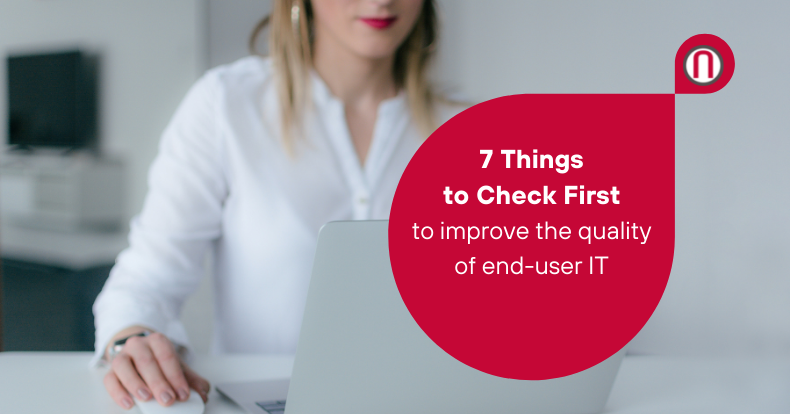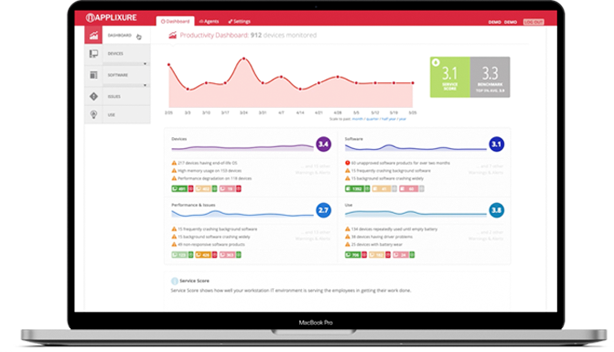One of the main goals of IT is to enable employees to be productive by making sure their primary tools – computers & software – are functioning properly. But what are the best ways to improve end-user IT? We asked CIOs and IT Managers, and here is what they said.
We asked our customers – CIOs and IT Managers - what their top tips are for improving end-user IT. Their recommendation was to start from the basics and tidy up the environment by taking a look at the following 7 issues:
Top 7 Things to Check First to Improve end-user IT:
 Software versions
Software versions
Even in the best managed environments, you’ll likely find a few versions of the same software. That’s perfectly fine. However, if you have more than that, you have a phenomenon called version sprawl.
What’s wrong with version sprawl? Several things:
- Harder to manage: The more versions you have, the harder it is to manage the environment. The harder an environment is to manage, the less time you have for things that can really move the needle.
- Sub-optimal user experience: When you have many software versions, that means that your employees are running old versions of the software. And older versions are often missing features that the newer versions have. In addition, assisting these people becomes harder as you need to be familiar with each version’s ins-and-outs.
- Security issues: Many times software updates include security improvements, so by allowing old versions to linger, you open your environment up to security threats.
So the #1 tip is to check if you have too many versions of a particular software and start working to reduce the number to as few as possible.
 Windows 10 builds
Windows 10 builds
Similar thing, but on the OS side. Too many build versions make management hard, leave you open to security threats, and keep the service desk team busy.
So, check your builds and work towards reducing the number to a more manageable level.
 Did OS updates install (or not?)
Did OS updates install (or not?)
Updated computers tend to run better and be more secure. But even if an update should have been installed, chances are some aren’t.
So, check if OSes are properly updated.
Update issues can often be caused by something as simple as users who are not re-starting their computers regularly. This is easy enough to fix by sending a reminder email to those people. Another reason may be that something went wrong in your distribution system.
 Bitlocker enabled
Bitlocker enabled
Most computers now have an encryption chip allowing fast disk encryption. However, there might be computers within your environment which don’t have Bitlocker enabled. Using Bitlocker improves your environment’s security.
 Performance degradation
Performance degradation
Performance degradation can happen for various reasons. Check if you have computers within your fleet that are running slower than they should be and dig a little deeper to find out why. Solving these issues can significantly improve your employees’ IT experience.
 Battery wear
Battery wear
Battery wear often goes unnoticed by users as it happens slowly. Little by little the battery runs out quicker and quicker, and the employee needs to plug the charger all the time. This is a major hassle, yet very easy to fix: Renew battery.
This is a particularly nice and easy fix that IT can provide, and end-users are quite pleasantly surprised when IT is able to proactively solve this problem.
 High memory usage
High memory usage
High memory usage is another issue which can often be easy to fix: upgrade the RAM. However, there might be other actions that solve the problem – like uninstalling or reconfiguring software, or training employees to close unnecessary files and quit unnecessary applications.
Where can you find this data?
So where do you look to find this data about software versions, windows builds, updates etc. The data is likely available in your IT management systems. However, often it’s not in an ready-to-use format and downloading and analyzing it to get the insights takes time. On top of that, the analysis is only of a snapshot in time, so the insights are quickly outdated.
We noticed this too. And to make up-to-date actionable data available to you at all times, we created Applixure.
Applixure pulls the relevant data about your computers and software into intuitive dashboards and clearly indicates high-impact yet easy-to-fix issues - enabling your IT to be more proactive. Set-up is quick, so you can start reaping the benefits almost overnight. If you are interested in an easier way to get access to that actionable data, you can learn more about Applixure on our product page >
Whichever way you decide to access your date, if you pay attention to the 7 issues listed above, your environment will be healthier and your end-users should experience less IT hassles.




